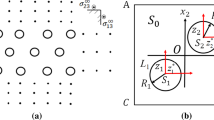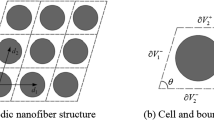Abstract
We propose an innovative numerical scheme (based on complex variable techniques) for the calculation of the effective properties of a composite containing unidirectional periodic fibers in which we additionally incorporate the separate contribution of the ‘interface effect’ between the fibers and the surrounding material. The incorporation of interface effect into the model of deformation allows our model to accommodate the general class of nanocomposite materials, a fast growing area of research and our primary focus in this paper. The composite is loaded by a constant normal strain along the direction parallel to the fibers and by a uniform remote loading in the plane perpendicular to the fibers. Our method is based on the analysis of a representative unit cell with periodic boundary conditions imposed on its edge. Several examples are presented to study the influence of the interface and the volume fraction of the fibers on the effective properties of the composite and the interfacial stress field. We show that when the volume fraction falls below roughly 9%, the interfacial stress distribution recovers effectively to that corresponding to a single fiber with the same interface parameters embedded within an infinite matrix. We find also that if the shear modulus of the fibers exceeds approximately two and a half times that of the matrix, the interface effect is negligible in the determination of the effective properties of the corresponding nanocomposites. Finally, we show that the use of traditional effective medium theories may induce significant errors in the determination of transverse effective properties (in the plane perpendicular to the fibers) of the composite, in particular when the fibers are significantly softer than the matrix.















Similar content being viewed by others
References
Gurtin, M.E., Murdoch, A.I.: A continuum theory of elastic material surfaces. Arch. Ration. Mech. Anal. 57(4), 291–323 (1975)
Gurtin, M.E., Weissmüller, J., Larche, F.: A general theory of curved deformable interfaces in solids at equilibrium. Philos. Mag. A 78(5), 1093–1109 (1998)
Duan, H.L., Wang, J., Huang, Z.P., Karihaloo, B.L.: Size-dependent effective elastic constants of solids containing nano-inhomogeneities with interface stress. J. Mech. Phys. Solids 53, 1574–1596 (2005)
Chen, T., Dvorak, G.J., Yu, C.C.: Size-dependent elastic properties of unidirectional nano-composites with interface stresses. Acta Mech. 188, 39–54 (2007)
Xiao, J.H., Xu, Y.L., Zhang, F.C.: Evaluation of effective electroelastic properties of piezoelectric coated nano-inclusion composites with interface effect under antiplane shear. Int. J. Eng. Sci. 69, 61–68 (2013)
Xu, Y., He, Q.C., Gu, S.T.: Effective elastic moduli of fiber-reinforced composites with interfacial displacement and stress jumps. Int. J. Solids Struct. 80, 146–157 (2016)
Dai, M., Schiavone, P., Gao, C.F.: Prediction of the stress field and effective shear modulus of composites containing periodic inclusions incorporating interface effects in anti-plane shear. J. Elast. 125, 217–230 (2016)
Mogilevskaya, S.G., Crouch, S.L., Stolarski, H.K., Benusiglio, A.: Equivalent inhomogeneity method for evaluating the effective elastic properties of unidirectional multi-phase composites with surface/interface effects. Int. J. Solids Struct. 47, 407–418 (2010)
Wang, H.W., Zhou, H.W., Peng, R.D., Mishnaevsky, L.: Nanoreinforced polymer composites: 3D FEM modeling with effective interface concept. Compos. Sci. Technol. 71, 980–988 (2011)
Yvonnet, J., Quang, H.L., He, Q.C.: An XFEM/level set approach to modelling surface/interface effects and to computing the size-dependent effective properties of nanocomposites. Comput. Mech. 42, 119–131 (2008)
López-Realpozo, J.C., Rodríguez-Ramos, R., et al.: Effective elastic shear stiffness of a periodic fibrous composite with non-uniform imperfect contact between the matrix and the fibers. Int. J. Solids Struct. 51, 1253–1262 (2014)
Guinovart-Díaz, R., Rodríguez-Ramos, R., et al.: Analysis of fibrous elastic composites with nonuniform imperfect adhesion. Acta Mech. 227, 57–73 (2016)
Muskhelishvili, N.I.: Some Basic Problems of the Mathematical Theory of Elasticity. Noordhoff, Groningen (1975)
Tian, L., Rajapakse, R.: Analytical solution for size-dependent elastic field of a nanoscale circular inhomogeneity. ASME J. Appl. Mech. 74, 568–574 (2007)
Dai, M., Schiavone, P., Gao, C.F.: Uniqueness of neutral elastic circular nano-inhomogeneities in antiplane shear and plane deformations. ASME J. Appl. Mech. 83, 101001 (2016)
Xia, Z., Zhang, Y., Ellyin, F.: A unified periodical boundary conditions for representative volume elements of composites and applications. Int. J. Solids. Struct. 40, 1907–1921 (2003)
Dai, M., Sun, H.: Thermo-elastic analysis of a finite plate containing multiple elliptical inclusions. Int. J. Mech. Sci. 75, 337–344 (2013)
Dai, M., Meng, L.C., Huang, C., Gao, C.F.: Electro-elastic fields around two arbitrarily-shaped holes in a finite electrostrictive solid. Appl. Math. Model 40, 4625–4639 (2016)
Ruud, J.A., Witvrouw, A., Spaepen, F.: Bulk and interface stresses in silver-nickel multilayered thin films. J. Appl. Phys. 74, 2517–2523 (1993)
Josell, D., Bonevich, J.E., Shao, I., Cammarata, R.C.: Measuring the interface stress: Silver/nickel interfaces. J. Mater. Res. 14, 4358–4365 (1999)
Acknowledgements
Dai appreciates the support of the China Scholarship Council. Dai and Gao acknowledge the support of the National Natural Science Foundation of China (11232007 and 11472130) and a Project Funded by the Priority Academic Program Development of Jiangsu Higher Education Institutions (PAPD). Schiavone thanks the Natural Sciences and Engineering Research Council of Canada for their support through a Discovery Grant (Grant # RGPIN 155112).
Author information
Authors and Affiliations
Corresponding author
Ethics declarations
Conflict of interest
The authors declare that they have no conflict of interest.
Appendix
Appendix
The average out-of-plane normal stress in the RUC is defined by
In (43), using Green’s theorem and Eqs. (4), (6), (7) and (14), the integrals over the region \(S_{1}\) and the curve L can be given explicitly by the coefficient \(a_{11}\) as
while the integral over the region \(S_{0}\) can be evaluated from
via numerical quadrature.
Rights and permissions
About this article
Cite this article
Dai, M., Schiavone, P. & Gao, CF. A new method for the evaluation of the effective properties of composites containing unidirectional periodic nanofibers. Arch Appl Mech 87, 647–665 (2017). https://doi.org/10.1007/s00419-016-1215-8
Received:
Accepted:
Published:
Issue Date:
DOI: https://doi.org/10.1007/s00419-016-1215-8




